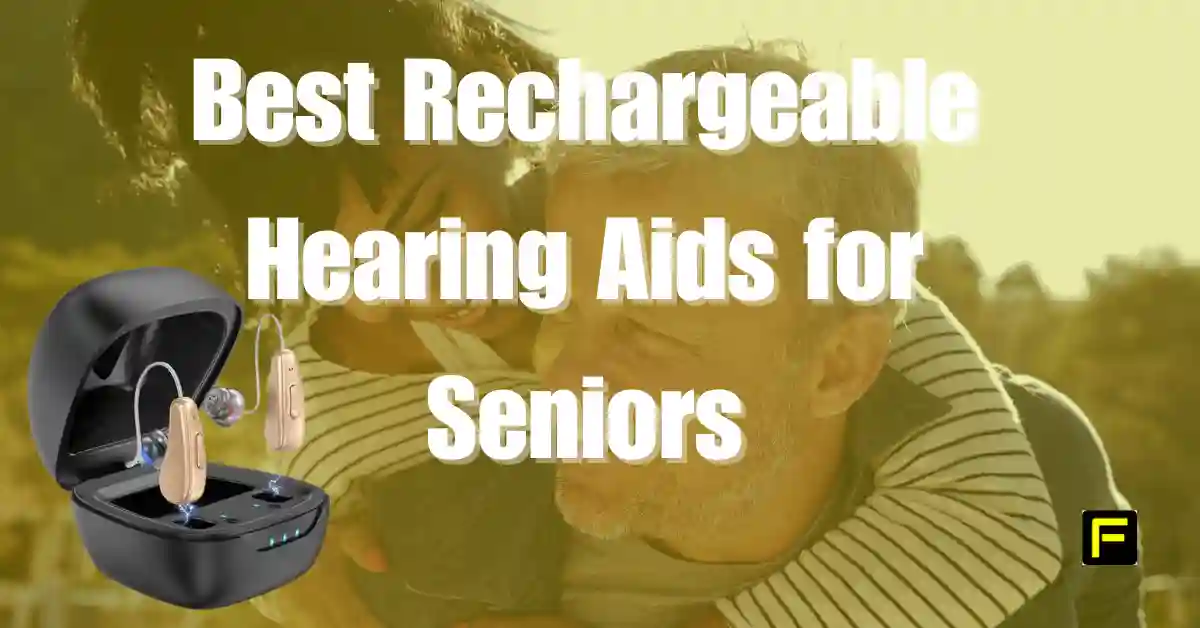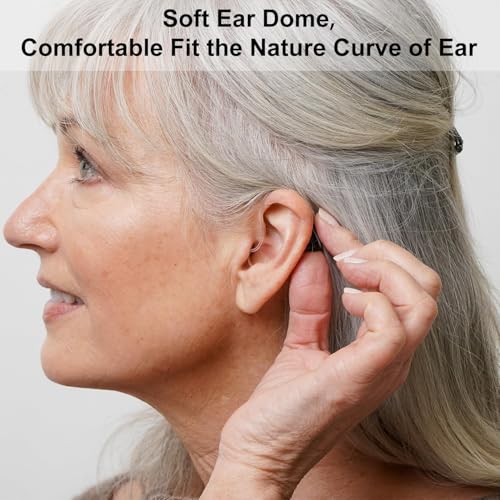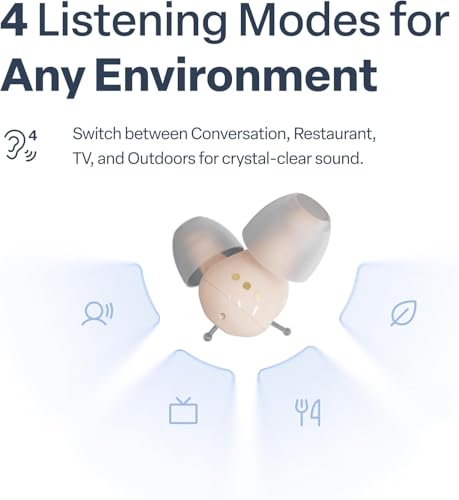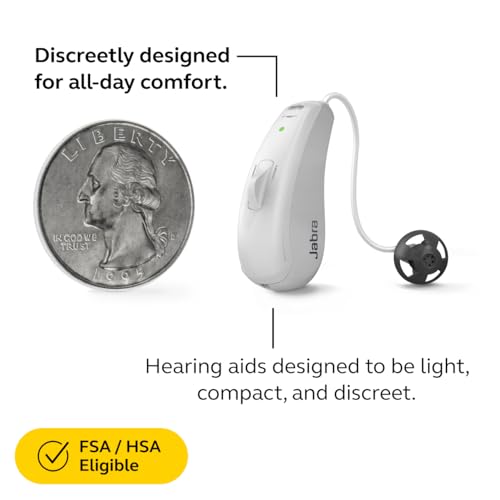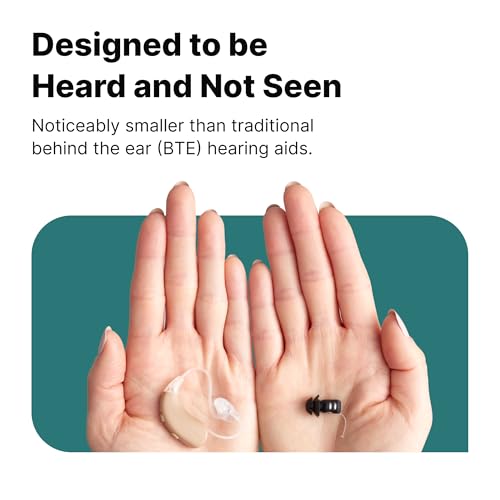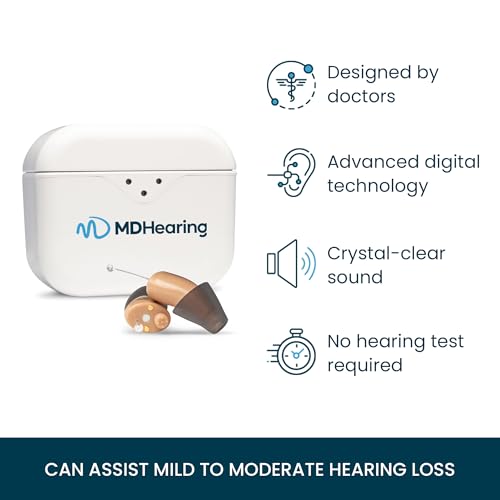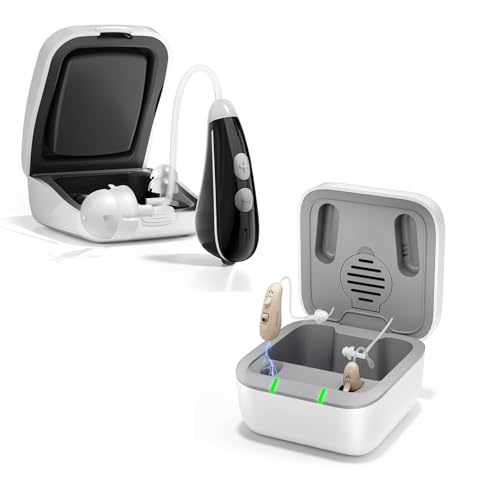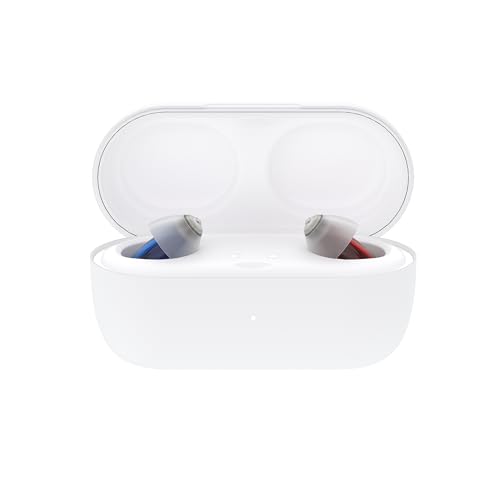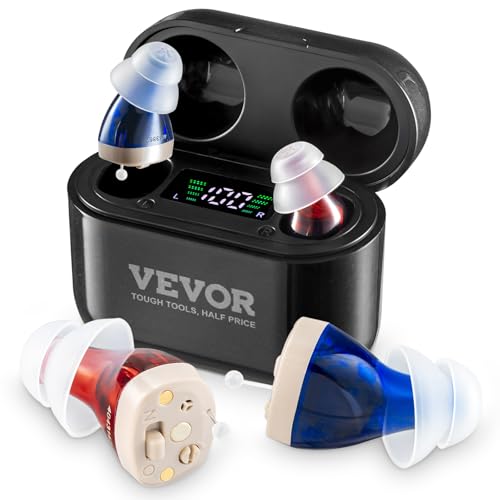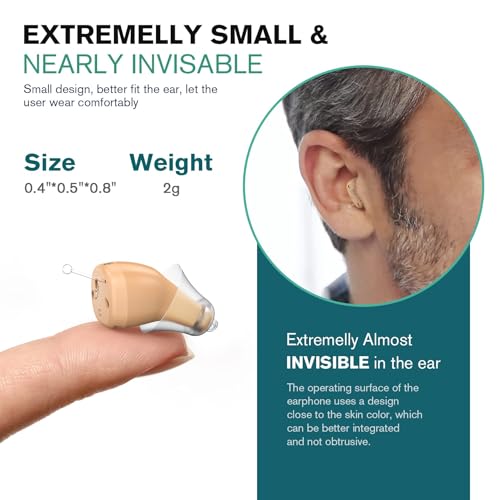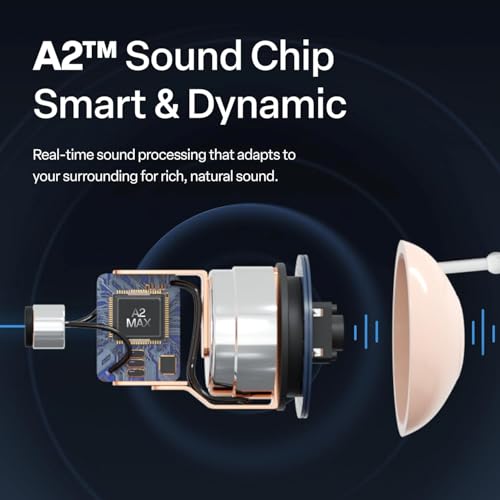Struggling to hear colleagues in meetings. Missing conversations in crowded restaurants. Asking ‘what?’ constantly. Here’s the game-changer: The 2017 Over-the-Counter Hearing Aid Act lets you buy effective hearing aids without audiologist appointments or prescriptions—saving $2,000-$5,000.
Modern rechargeable options eliminate tiny batteries and actually work. This guide compares 12 tested devices by price, features, and lifestyle. You’ll know exactly which one fits your needs.
Table of Contents
Top 3 Rechargeable Hearing Aids for Seniors (Quick Picks)
| Your Main Concern | My Top Pick | Why It Wins |
|---|---|---|
| Easiest to use overall | Audien Atom Pro 2 | Wireless charging with UV cleaning, minimal buttons, foolproof operation |
| Best technology + support | Jabra Enhance Select 50R | Professional remote tuning, excellent app, responsive customer service |
| Most discreet appearance | Eargo SE | Completely-in-canal design, virtually invisible, comfortable long-term wear |
The 12 Best Rechargeable Hearing Aids for Seniors (Detailed Reviews)
I’ve organized these by use case rather than arbitrary ranking, because the “best” hearing aid depends entirely on your specific situation.
For Most People: Best All-Around Value
1. Audien Atom Pro 2 (OTC)
Price Range: 289-349 | Style: Virtually invisible in-ear | Battery Life: 20+ hours
Why I recommend this first: The Audien Atom Pro 2 represents the sweet spot of price, performance, and simplicity. In my experience, this is the device that gets actually worn rather than sitting in a drawer.
Key Features:
- Wireless charging case with UV sanitizing (kills 99.9% of bacteria—important when something sits in your ear all day)
- Nearly invisible when worn
- No smartphone required for operation
- Four volume presets (simple toggle button)
- Comfortable for extended wear
Who this works best for:
- First-time hearing aid users who want simple operation
- Anyone intimidated by apps and Bluetooth pairing
- Seniors with arthritis (easy to handle, no tiny batteries)
- Budget-conscious buyers who don’t want to sacrifice quality
Honest limitations:
- No app customization (pro or con depending on your tech comfort)
- Not ideal for severe hearing loss
- No streaming audio from phone
My client experience: I recommended these to my 72-year-old client Helen who has moderate arthritis. Six months in, she tells me, “I just put them in every morning and forget about them. They work.” That’s exactly what you want.
For Tech-Savvy Seniors: Best App Control & Support
2. Jabra Enhance Select 50R
Price Range: 1,595/pair | Style: Receiver-in-canal (RIC) | Battery Life: 30 hours
Why this costs more—and when it’s worth it: Jabra Enhance offers professional-grade technology with remote audiologist support. You’re paying for sophisticated sound processing and ongoing tuning.
Key Features:
- Remote programming by licensed professionals (included in price)
- Excellent speech-in-noise technology
- Bluetooth streaming for phone calls and music
- Rechargeable with portable charging case
- 3-year warranty with loss/damage protection
Who this works best for:
- Active seniors who want the best audio quality
- iPhone/Android users who want streaming capability
- Anyone with more complex hearing loss patterns
- People who value professional support without office visits
Honest limitations:
- Highest price point on this list
- Requires smartphone for full functionality
- Larger behind-the-ear style (more visible)
- Learning curve for app features
When to choose this over cheaper options: If you can afford the investment and you’re still socially active—dining out, attending events, participating in group activities—the superior noise cancellation and speech clarity justify the cost. My client Jim, age 68, spent months frustrated with cheaper devices before switching to these. His comment: “I can finally hear my grandkids without everyone having to shout.”
For Maximum Discretion: Most Invisible Option
3. Eargo SE
Price Range: 799-999 | Style: CIC (completely-in-canal) | Battery Life: 16+ hours
Why discretion matters more than we admit: I’ve had clients literally skip family gatherings because they felt self-conscious about visible hearing aids. If that resonates, read carefully.
Key Features:
- Virtually invisible when worn (sits deep in ear canal)
- Comfortable Flexi Palms design (soft silicone petals instead of hard ear molds)
- Good sound quality for mild-moderate loss
- Rechargeable portable case (3 additional charges on-the-go)
- Whisper-quiet operation (no feedback squealing)
Who this works best for:
- Seniors still working who want professional discretion
- Anyone self-conscious about appearance
- People who found traditional ear molds uncomfortable
- Those with smaller ear canals
Honest limitations:
- Shorter battery life than behind-the-ear models
- Can feel strange initially (deep insertion)
- Not suitable for severe hearing loss
- More expensive than similarly-featured BTE models
Fit consideration: The CIC style requires that you can physically insert and remove devices from your ear canal. If dexterity is significantly limited, the behind-the-ear models (like Jabra or Wellue) are easier to handle.
Budget-Friendly Options That Don’t Sacrifice Quality
4. MDHearing VOLT+
Price Range: 397/pair | Style: Behind-the-ear (BTE) | Battery Life: 18-20 hours
The value proposition: MDHearing has built a reputation for straightforward, effective devices at accessible prices. No frills, but all the essentials work well.
Key Features:
- Doctor-designed for mild-moderate loss
- Easy-to-handle BTE design (great for arthritis)
- Four environmental programs (quiet, restaurant, outdoor, phone)
- Affordable replacement parts
- 45-day trial period
Who this works best for:
- First-time users on fixed incomes
- Seniors who prioritize function over features
- Anyone who tried cheap Amazon amplifiers and wants a real upgrade
- People in quieter environments most of the day
My take: This is honest value—not luxury, but genuinely helpful. I recommend MDHearing when clients say, “Rick, I just need something that works without breaking the bank.”
5. ELEHEAR Beyond AI
Price Range: 599-799 | Style: BTE with AI processing | Battery Life: 24+ hours
The AI advantage: This device learns your listening environments over time and automatically adjusts. Sounds like marketing hype, but the technology actually works.
Key Features:
- AI-powered noise reduction that improves with use
- Bluetooth streaming (music, calls, podcasts)
- App control with custom programs
- Magnetic charging dock
- Tinnitus masking features
Who this works best for:
- Tech-comfortable seniors (requires initial app setup)
- Active lifestyles with varied sound environments
- Anyone with tinnitus (the white noise feature helps)
- People who struggled with “everything sounds too loud” in other devices
The learning curve: Expect 2-3 weeks for the AI to optimize to your patterns. My client Margaret was ready to return these after week one, but by week four she called them “life-changing.” Patience pays off.
6. Ceretone Fusion
Price Range: 349-449 | Style: RIC | Battery Life: 20 hours
Budget-friendly tech: Ceretone offers surprisingly good technology at mid-range prices. Think of this as the “best features per dollar” option.
Key Features:
- Clear sound with minimal distortion
- Rechargeable with fast-charge option (90 minutes full)
- Feedback cancellation (reduces whistling)
- Four listening modes
- Lightweight comfortable fit
Who this works best for:
- Seniors wanting BTE convenience without premium cost
- Anyone upgrading from basic amplifiers
- People who need reliable performance without complexity
- Budget around $400 per ear
Honest assessment: These won’t impress audiophiles, but they provide solid, dependable performance for typical daily scenarios—TV, conversation, outdoor activities.
7. Ceretone Torch
Price Range: 449-549 | Style: BTE | Battery Life: 22+ hours
Step up from Fusion: The Torch adds adaptive noise control that Fusion lacks. Worth the $100 difference if you’re in noisy environments regularly.
Key Features:
- Adaptive directional microphones (focuses on voices in front of you)
- Wind noise reduction (great for outdoor activities)
- Bluetooth optional pairing
- Durable water-resistant housing
- Volume memory (remembers your preferred settings)
Who this works best for:
- Outdoor enthusiasts (gardening, walking, golf)
- Anyone in windy climates
- Seniors who found cheaper devices useless in restaurants
- Active lifestyles with varied sound challenges
8. Wellue Self-Fitting BTE
Price Range: 399-499 | Style: Behind-the-ear | Battery Life: 20 hours
The self-fitting advantage: Wellue includes a hearing test via the app that customizes sound profile to your specific loss pattern. More personalized than one-size-fits-all presets.
Key Features:
- Built-in hearing test for personalization
- Large, easy-to-manipulate design
- Clear speech enhancement
- Rechargeable with travel case
- 30-day money-back guarantee
Who this works best for:
- Seniors with asymmetrical hearing loss (different in each ear)
- Anyone who can’t easily get to an audiologist
- First-timers who want some customization without professional fees
- People comfortable with 10-minute app-based setup
Important note: The self-fitting test is helpful but not equivalent to professional audiometry. If results seem off, consider an actual hearing test.
Specialty & Budget Options
9. VEVOR Rechargeable Amplifier
Price Range: 89-129 | Style: BTE amplifier | Battery Life: 15+ hours
Setting expectations: This is a personal sound amplifier, not an FDA-registered hearing aid. There’s a difference—but it has legitimate uses.
Key Features:
- Extremely affordable entry point
- Simple volume and tone controls
- Rechargeable (USB-C)
- Good as backup device
- No prescription or medical device regulations
Who this works best for:
- Seniors experimenting to see if amplification helps
- Backup device for occasional use
- Very mild hearing difficulty
- Temporary solution while saving for quality devices
My honest take: I recommend this to clients who are skeptical about whether hearing aids will help. It’s cheap enough that if it doesn’t work, you’re not out significant money. But if you DO notice improvement, invest in a proper hearing aid—amplifiers don’t provide the frequency-specific adjustment you need for actual hearing loss.
10. Chosgo K19 (CIC)
Price Range: 199-299 | Style: Completely-in-canal | Battery Life: 14-16 hours
Ultra-budget discreet option: If you want invisible styling but can’t afford Eargo, this is worth considering.
Key Features:
- Nearly invisible CIC design
- Portable charging case
- Four volume levels
- Small and lightweight
- 45-day return window
Who this works best for:
- Budget-conscious buyers who want discretion
- Mild hearing loss only
- Smaller ear canals
- Trial before investing more
Trade-offs: Battery life is shorter than BTE models, sound quality is adequate but not exceptional, and customer service is limited compared to premium brands. You get what you pay for—but sometimes “adequate” is perfectly fine.
11. Medca ITC Nano
Price Range: 149-229 | Style: In-the-canal | Battery Life: 18 hours
Simple and portable: The Medca focuses on ease of transport and one-button operation—perfect for seniors who want minimal fuss.
Key Features:
- Single button control (volume/power)
- Compact charging case fits in pocket
- Decent battery life for price point
- Soft ear tips included (multiple sizes)
- Affordable replacement if lost
Who this works best for:
- Extremely price-sensitive budgets
- Seniors who lose things frequently (replaceable without major cost)
- Very basic hearing support needs
- Anyone wanting to try CIC style affordably
Reality check: At $150, you’re getting basic amplification with minimal sound processing. It will make things louder—it won’t necessarily make speech clearer or reduce background noise effectively.
12. Hammacher Schlemmer Pre-Tuned Rechargeable
Price Range: 299-399 | Style: BTE | Battery Life: 20 hours
Ready-to-wear concept: Hammacher markets these as pre-tuned for typical age-related hearing loss patterns. No setup, no app—just turn on and go.
Key Features:
- Zero configuration required
- Comfortable over-ear design
- Magnetic charging stand
- Lifetime product support (Hammacher’s policy)
- Good for technology-averse users
Who this works best for:
- Seniors who refuse to deal with apps or pairing
- Classic hearing loss pattern (high-frequency difficulty)
- Anyone who values plug-and-play simplicity
- Gift-givers looking for foolproof option
The limitation: Pre-tuned means one-size-fits-all. If your hearing loss doesn’t match their preset profile, these won’t work well. The trade-off for simplicity is lack of customization.
Side-by-Side Comparison: Key Specs
| Model | Price | Style | Battery | Bluetooth | Best For |
|---|---|---|---|---|---|
| Audien Atom Pro 2 | $289 | Nearly invisible | 20h | No | First-timers, simplicity |
| Jabra Enhance 50R | $1,595 | RIC | 30h | Yes | Best quality, support |
| Eargo SE | $999 | CIC | 16h | No | Maximum discretion |
| MDHearing VOLT+ | $397 | BTE | 18h | No | Budget quality |
| ELEHEAR Beyond AI | $699 | BTE | 24h | Yes | AI learning, tech users |
| Ceretone Fusion | $399 | RIC | 20h | No | Value features |
| Ceretone Torch | $499 | BTE | 22h | Optional | Outdoor/active |
| Wellue Self-Fitting | $449 | BTE | 20h | No | Personalization |
| VEVOR Amplifier | $109 | BTE | 15h | No | Trial/backup |
| Chosgo K19 | $249 | CIC | 14h | No | Budget invisible |
| Medca Nano | $189 | ITC | 18h | No | Ultra-budget |
| Hammacher Pre-Tuned | $349 | BTE | 20h | No | Zero setup |
Why Choose Rechargeable Hearing Aids?
Rechargeable hearing aids eliminate the need for tiny disposable batteries—making them ideal for seniors with limited dexterity or vision. Similar to how we’ve seen mobility aids become more accessible (like the rollator walkers designed for taller individuals), hearing technology has evolved to prioritize senior-friendly design. They offer 18–30 hours per charge, recharge in about two hours, and are eco-friendly.
The 5-Year Cost Analysis
Let me show you the math I walk every client through:
Disposable Battery Hearing Aid:
- Device cost: $400-800
- Batteries: ~60 packs per year × $8 = $480/year
- 5-year total: $800 + ($480 × 5) = $3,200
Rechargeable Hearing Aid:
- Device cost: $500-1,200 (one-time)
- Electricity to charge: ~$3/year
- Battery replacement (year 4): $50-100
- 5-year total: $1,200 + $15 + $100 = $1,315
You save approximately $1,900 over five years while eliminating the frustration of changing tiny batteries every 5-7 days.
Beyond Cost: Why I Recommend Rechargeable for Most Seniors
- Dexterity Issues – If you have arthritis, tremors, or reduced finger strength (common challenges we address in our exercises for seniors with joint concerns), those miniature button batteries are genuinely difficult to handle.
- Vision Concerns – The batteries are the size of a pencil eraser. If you need reading glasses, good luck seeing which way is positive/negative at 6 AM.
- Cognitive Load – One less thing to remember and manage. Drop them in the charger at night, grab them in the morning. Simple routine.
- Environmental Impact – Those zinc-air batteries create significant waste. If environmental stewardship matters to you, rechargeable is the ethical choice.
How to Pick the Right Hearing Aid
Battery life: Aim for at least 18 hours per charge.
Ease of use: Big buttons and simple menus help—especially important if you’ve experienced challenges with maintaining balance and coordination after 60.
Noise control: Look for speech-in-noise features if you’re still socially active.
Bluetooth / App: Useful for phone calls and streaming, but only if you’re comfortable with technology.
Comfort: BTE is easiest to handle; CIC is most discreet. Consider your priorities alongside any arthritis concerns.
Warranty: Choose a brand with strong support—you’re making an investment in your quality of life.
When to See an Audiologist vs. Trying OTC Hearing Aids
This is critical: OTC hearing aids are FDA-approved for mild to moderate hearing loss only. Here’s how to know which category you’re in:
Try OTC First If:
- You struggle to hear in noisy restaurants or group settings
- You frequently ask people to repeat themselves
- You turn up the TV volume (and others complain)
- You hear ringing or buzzing (tinnitus) occasionally
- Phone conversations are getting harder
See an Audiologist or ENT Doctor If:
- You have sudden hearing loss (within 72 hours—this is a medical emergency)
- Hearing loss in only one ear
- Ear pain, drainage, or feeling of fullness
- Severe hearing loss (can’t hear normal conversation even in quiet rooms)
- History of ear surgery or chronic ear infections
- Dizziness or balance problems accompanying hearing loss
Medicare coverage note: Original Medicare does NOT cover hearing aids (frustrating, I know). However, some Medicare Advantage plans offer partial coverage. If cost is a significant barrier, check with your plan before purchasing OTC devices.
My Decision Framework: Which Hearing Aid Matches Your Situation?
Let me walk you through the same questions I ask my clients:
Question 1: What’s your realistic budget?
- Under $300: Audien Atom Pro 2, Chosgo K19, or Medca Nano
- $300-600: MDHearing VOLT+, Ceretone Fusion/Torch, ELEHEAR Beyond AI
- $600-1,000: Eargo SE, Wellue Self-Fitting
- $1,000+: Jabra Enhance Select 50R
Question 2: How’s your dexterity and vision?
- Arthritis/limited dexterity: BTE models (Jabra, MDHearing, Ceretone, Wellue)
- Vision challenges: Larger BTE with tactile buttons (avoid tiny CIC models)
- Good dexterity: Any style works; CIC offers best discretion
Question 3: How tech-comfortable are you?
- Love technology: Jabra Enhance, ELEHEAR Beyond AI
- Moderately comfortable: Wellue Self-Fitting, Ceretone Torch
- Technology-averse: Audien Atom Pro 2, MDHearing VOLT+, Hammacher Pre-Tuned
Question 4: What’s your typical environment?
- Mostly quiet home: Budget options work fine (MDHearing, Ceretone Fusion)
- Active social life: Invest in noise-canceling tech (Jabra, ELEHEAR)
- Varied environments: Adaptive models (Ceretone Torch, ELEHEAR Beyond AI)
- Outdoor activities: Wind-resistant models (Ceretone Torch, Jabra)
Question 5: How important is appearance?
- Very concerned: Eargo SE, Audien Atom Pro 2, Chosgo K19
- Somewhat concerned: Smaller BTE or RIC models
- Not concerned: Focus on functionality over style
My Quick Recommendation by Profile:
“I just need basic help hearing the TV and conversations, don’t want to spend much”
→ MDHearing VOLT+ ($397) or Audien Atom Pro 2 ($289)
“I’m still very active socially and want the best noise cancellation”
→ Jabra Enhance Select 50R ($1,595) or ELEHEAR Beyond AI ($699)
“I’m self-conscious and want them invisible”
→ Eargo SE ($999) or Audien Atom Pro 2 ($289)
“I want good quality but have a fixed budget around $400”
→ Ceretone Fusion ($399) or Wellue Self-Fitting ($449)
“I hate technology and just want simple”
→ Hammacher Pre-Tuned ($349) or Audien Atom Pro 2 ($289)
The First 30 Days: Your Adjustment Period Roadmap
Here’s what nobody tells you: hearing aids feel weird at first. Your brain has spent years compensating for hearing loss, and suddenly reintroducing sounds it hasn’t processed properly creates sensory overload. This is completely normal—much like how your body adapts when you start a new exercise routine after 50.
Week 1: Expect Strangeness
What you’ll experience:
- Your own voice sounds odd (louder, echoing, tinny)
- Everything seems too loud (rustling papers, footsteps, refrigerator hum)
- Mental fatigue by afternoon (your brain is working hard!)
- Occasional feedback squealing (until you adjust fit)
What to do:
- Wear them 2-4 hours per day in quiet environments
- Start at lower volume settings
- Practice in your home before going public
- Remove them when overwhelmed—this is a marathon, not sprint
Don’t quit yet: 90% of first-time users want to return their devices during week one. This is the adaptation period, not device failure.
Week 2: Gradual Improvement
What you’ll experience:
- Your voice starts sounding more normal
- You can distinguish speech from background noise better
- Fatigue decreases
- You forget you’re wearing them for periods
What to do:
- Increase wearing time to 6-8 hours daily
- Try slightly noisier environments (small gatherings, quieter restaurants)
- Experiment with volume settings
- Keep notes on what situations are still challenging
Week 3-4: Breakthrough Point
What you’ll experience:
- “Oh, THAT’S what I’ve been missing” moments
- Genuine appreciation for sounds you’d forgotten (birds, music, grandkids’ laughter)
- Confidence in various environments
- Wearing them becomes automatic
What to do:
- Wear them full-time during waking hours
- Test challenging situations (busy restaurants, group meetings)
- Fine-tune settings for different environments
- Consider follow-up with audiologist if models allow remote adjustment
Red Flags—When to Seek Professional Help:
- Pain or persistent discomfort after proper adjustment
- No improvement in speech clarity after 30 days
- Constant feedback/whistling that adjustment doesn’t fix
- Dizziness or headaches when wearing devices
- Hearing continues to worsen despite devices
Tips for First-Time Users
- Charge nightly, like your phone – Make this part of your evening routine, just as you would with maintaining any health equipment.
- Keep the case dry and clean – Moisture is the enemy of electronics.
- Start with moderate volume, adjust slowly – Your ears need time to adapt.
- Carry a portable charger when traveling – Many models include charging cases for on-the-go power.
- Have annual hearing checks – Hearing loss often progresses, so regular monitoring ensures your devices still meet your needs.
Maintenance & Care: Making Your Investment Last
Rechargeable hearing aids should last 4-6 years with proper care. Here’s my maintenance protocol I share with all clients:
Daily Routine (2 minutes):
- Morning: Inspect for earwax buildup, wipe clean with soft cloth
- Evening: Place in charging case/dock (make this automatic like plugging in your phone)
- Weekly: Use cleaning brush (usually included) to clear microphone ports
Weekly Deep Clean (5 minutes):
- Remove ear tips/domes, wash in warm soapy water, dry thoroughly
- Check for cracks or damage
- Wipe down entire device with slightly damp cloth (never submerge unless marked waterproof)
- Inspect charging contacts for corrosion
Monthly Checklist:
- Replace ear tips if torn or dirty (order replacements every 3-4 months)
- Update device firmware if app-connected
- Test battery life (should still last advertised hours)
- Check warranty expiration date
Storage Tips:
- Never leave in extreme heat (car dashboard in summer = death sentence)
- Keep away from moisture when not wearing (bathroom counter during shower = bad idea)
- Store in protective case when traveling
- Keep charging case clean and dry
Common Problems & DIY Fixes:
Whistling/Feedback:
- Check fit—device may not be seated properly
- Clean earwax buildup from speaker port
- Reduce volume slightly
- Replace dome/tip if stretched out
Sound Quality Degraded:
- Clean microphone ports (most common culprit)
- Charge fully (low battery reduces performance)
- Check for software updates
- Replace ear tips if creating poor seal
Won’t Charge:
- Clean charging contacts with dry cotton swab
- Try different power outlet
- Check cable for damage
- Contact manufacturer (charging port failure covered by most warranties)
Uncomfortable After Hours of Wear:
- Try different size ear tip/dome
- Remove for 15-minute breaks initially
- Check for rough edges on device
- Consider switching to different style (BTE vs CIC)
The Money Questions: Insurance, Financing, and Cost Management
Medicare Coverage Reality Check:
Original Medicare (Parts A & B): Does NOT cover hearing aids or exams for fitting hearing aids. Frustrating, but that’s current policy.
Medicare Advantage (Part C): Many plans offer partial coverage—typically $500-$1,500 allowance every 1-3 years. Check your specific plan’s coverage.
Medicaid: Coverage varies by state. Some states cover hearing aids for seniors; many don’t. Check with your state Medicaid office.
Other Insurance Options:
- VA Benefits: Veterans qualify for free or low-cost hearing aids through VA healthcare
- AARP Hearing Solutions: Members get discounted pricing (not insurance, but negotiated rates)
- CareCredit: Medical financing with 0% interest promotional periods (read terms carefully)
Reduce Your Out-of-Pocket Costs:
- FSA/HSA Accounts: Hearing aids qualify as eligible medical expenses
- Tax Deduction: If itemizing, hearing aids count as medical expenses
- State Programs: Some states offer assistance programs for seniors
- Nonprofit Organizations: Hearing charities sometimes provide free/discounted devices
- Manufacturer Trials: Use 30-60 day trial periods to test before committing
When to Replace vs. Repair:
Replace if:
- Devices are 5+ years old and battery life severely degraded
- Hearing loss has worsened significantly (current devices no longer adequate)
- Technology improvements justify cost (speech-in-noise processing has improved dramatically)
- Repair cost exceeds 50% of replacement cost
Repair if:
- Under warranty (always use warranty)
- Minor issues (earwax blockage, loose wire, charging port)
- Devices still meet your hearing needs
- Cost under $100-150
Frequently Asked Questions
How long does one charge last?
18–30 hours depending on use and Bluetooth activity. Manufacturer claims of “24-hour battery life” assume moderate use. Real-world factors include Bluetooth streaming (cuts battery life by 30-40%), high volume settings (reduces life by 20-30%), and cold weather (lithium batteries lose 10-15% capacity below freezing).
When will the battery need replacing?
Usually every 3–6 years. Check your warranty. Modern lithium rechargeable batteries maintain 80% capacity for roughly 500 charge cycles. After 5-6 years, you’ll likely need to replace batteries ($50-150) or upgrade to newer technology.
Are OTC hearing aids safe for seniors?
Yes, for mild-to-moderate hearing loss. Severe loss requires an audiologist. The FDA regulates OTC devices specifically for this purpose, ensuring safety and effectiveness when used appropriately.
Can I stream phone calls or music?
Yes—models like Jabra and ELEHEAR support Bluetooth streaming. This turns your hearing aids into wireless earbuds for phone calls, music, podcasts, and audiobooks.
Can I shower or swim with rechargeable hearing aids?
Generally no. Most are water-resistant (sweat and light rain okay), not waterproof. Unless specifically marked IP68 rating, assume you must remove them before showering, swimming, or heavy sweating activities.
How do I handle hearing aids during air travel?
Hearing aids can stay in during TSA screening. Metal detectors don’t damage them. If screener asks, just say “I’m wearing hearing aids” and proceed normally. Bring charging cable in carry-on (not checked baggage).
What if my hearing loss gets worse?
App-enabled devices allow adjustment for mild progression. You can increase amplification in specific frequency ranges. If you’ve maxed out volume settings and still struggle to hear, it’s time for stronger devices or audiologist consultation.
The Bottom Line: My Final Recommendations
After walking you through 12 devices and mountains of information, let me give you the straightforward guidance I’d give my own family:
If I could buy only one device for most seniors:
Why: It hits the sweet spot of affordability, simplicity, effectiveness, and comfort. The wireless UV-cleaning charging case is brilliant for hygiene, it’s nearly invisible, and it just works without fuss. For 80% of seniors with mild-to-moderate hearing loss, this is the right choice.
If money isn’t the primary concern:
Why: You get audiologist-level sound quality, professional remote support, and technology that handles complex sound environments. If you’re still actively engaged in social activities, dining out, attending events—the superior noise cancellation and speech clarity justify the investment.
If you’re on a fixed income:
Why: This is the minimum I’d recommend spending for actual hearing aid quality (not just amplification). It’s simple, reliable, and from a company with good customer service. Will it impress audiophiles? No. Will it meaningfully improve your daily life? Absolutely.
If you’re embarrassed about wearing hearing aids:
Why: Completely invisible when worn, comfortable for all-day use, good sound quality. If vanity is the barrier preventing you from getting help, this removes that excuse. Your mental health and social engagement matter more than the price difference.
Take the First Step Today
Look, I understand the hesitation. I’ve had clients put off getting hearing aids for years—missing conversations with grandkids, avoiding social situations, struggling through every dinner out. Just as we encourage people to address joint pain early before it limits mobility, hearing loss deserves the same proactive attention. The regret I always hear: “I wish I’d done this sooner.”
Hearing loss is progressive. It doesn’t improve on its own. The good news: modern rechargeable hearing aids are easier to use, more affordable, and more effective than ever before.
Your action plan:
- This week: Choose a device based on your budget and lifestyle (use my decision framework above)
- Order with confidence: All devices on this list have 30-60 day trial periods. You risk nothing by trying.
- Commit to 30 days: Remember the adjustment period—week one is weird for everyone. Push through.
- Evaluate honestly: After one month, ask yourself: “Am I hearing better? Am I engaging more socially? Is this worth the cost?” If yes to any of those, you made the right choice.
- Get professional help if needed: If OTC devices don’t work after honest trial, see an audiologist. There’s no shame in needing stronger intervention.
The conversations you’re missing, the TV shows you’re not fully enjoying, the social situations you’re avoiding—they’re not coming back. But your hearing can improve starting today.
You’ve got this. And if you need clarification on any device or situation, I’m here to help. For more health and wellness guidance for active adults over 50, explore our complete resource library.
—Rick Huey
Disclaimer: I’m a senior fitness specialist, not an audiologist or licensed hearing healthcare professional. This guide reflects my 20 years of experience working with older adults, but it doesn’t replace professional medical advice. If you have concerns about your hearing, please consult with a qualified audiologist or ENT doctor. Severe hearing loss, sudden hearing loss, or hearing loss accompanied by pain requires professional medical evaluation.

Rick Huey is a fitness writer who has dedicated his life to living an active lifestyle. With more than 30 years of experience in the fitness industry, Rick is a respected contributor for FitFab50.com, where he shares his wealth of knowledge with a wide audience. His dedication to promoting the benefits of living an active lifestyle has inspired many people to pursue their own fitness journeys with enthusiasm and dedication.
Last update on 2025-12-16 / Affiliate links / Images from Amazon Product Advertising API
